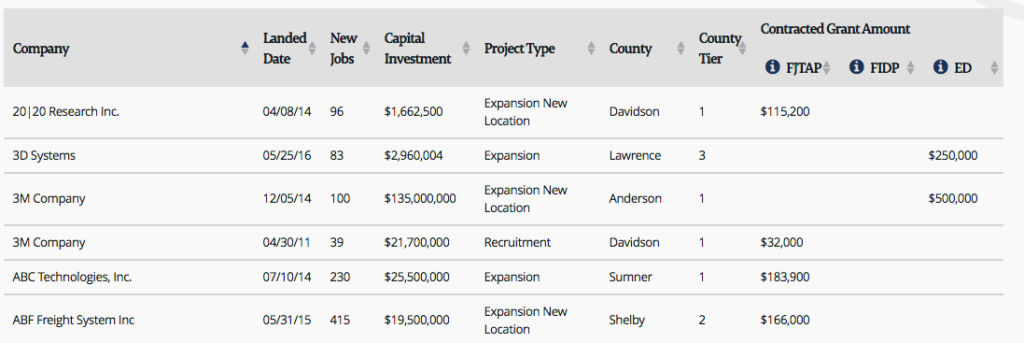ECD posts online database of FastTrack grants, but leaves out job creation
The Tennessee Department of Economic and Community Development has posted online a searchable database of FastTrack grants since 2011, but has left out key information it gathers on job creation.
Mike Reicher, a data reporter on The Tennessean’s investigative reporting team, writes about the development in some depth here: State releases list of business grants totaling $400 M.
There are many things to like about the database from an open government perspective.
For one, it replaces what essentially were PDFs of FastTrack grants, and PDFs of other documents associated with the grants, but in a jumble of different styles that made it difficult to make connections or draw any meaning from it.
The new database is a dramatic improvement: It allows you to search and sort the grants by county, number of jobs promised, amount of investment promised by the company, grant amount and type of grant, which is either an expansion of an existing business, or recruitment of an entirely new business.
 This is a major step forward in transparency of the grants — for citizens, for elected officials at the local and state level, for those in economic development industry and for business.
This is a major step forward in transparency of the grants — for citizens, for elected officials at the local and state level, for those in economic development industry and for business.
What’s not great about the database is that it leaves out key information that the state collects. Namely, the number of jobs created.
And, if you want to get picky, there is a field labeled “New Jobs,” but it’s not the number of new jobs created. It’s the number of jobs estimated to be created when the company got the grant. The label is misleading.
ECD has information on job creation. A few years ago, lawmakers passed a bill that required businesses who get FastTrack grants to report back annually to the state on the net new jobs created. Some of the expansions or new projects take multiple years to complete, so not all the new jobs will start right away.
That information is not in the database. It should be.
It’s worth noting that at least the PDFs of these job creation reports were posted online before. If ECD wasn’t going to include them in the database, perhaps they should have at least left the PDFs online.
A department spokeswoman said ECD is considering adding that information to the database later. But for now, if you want to know if the grants actually resulted in new jobs, you’ll need to file an public records request to get it.
All in all, ECD deserves a cheer that they got this database posted. I think it goes a long way in pushing back on the perception that the state is not transparent with its economic incentives. And that’s definitely a step in the right direction.




